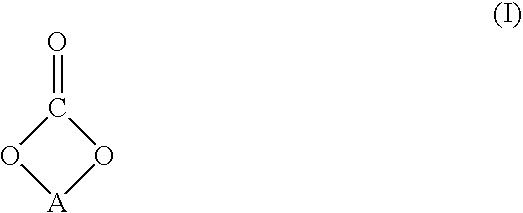Two-component bonding agent
a bonding agent and two-component technology, applied in the field of bonding agent systems, can solve the problems of unfavorable bonding effect of polyurethanes with nco groups used as “curing agents, formation of unwanted bubbles in the adhesive film, and moisture sensitivity
- Summary
- Abstract
- Description
- Claims
- Application Information
AI Technical Summary
Problems solved by technology
Method used
Image
Examples
example 1
[0067] In a 1 liter four-necked flask equipped with a stirrer, thermometer and an inlet and outlet valve for introducing inert gas were added 120 g polyol A, 100 g polyol B and 80 g polyol C, melted and dried for 1 hour at 120° C. under a pressure of <10 mbar. After venting with dry nitrogen, the inner temperature was lowered to 90° C. and 81.99 g MDI were added. The mixture was then further stirred at 100° C. After 1 hour the NCO number was 2.25 wt. %. 24.16 g of dried glycerine carbonate were added and stirring continued between 100 and 120° C. until the NCO number was lower than 0.1% wt. %. The resulting prepolymer had a melt viscosity of 49 Pa·s at 125° C.
example 2
[0068] 90 g of the prepolymer from Example 1 were dissolved with stirring in 100 g ethyl acetate at room temperature. Then 0.62 g DETA were added to 50 g of this solution and the mixture was homogenized for 15 minutes. This mixture was then coated onto a silicone paper with a doctor blade (gap 500 μm from Erichsen), left to dry in air at room temperature and the melt viscosity determined from time to time. The melt viscosity (measured at 125° C.) was 1.6 Pa·s after 1 hour, 13 Pa·s after 24 hours and 74 Pa·s after 4 days. After 15 days the film had an ultimate tensile strength of 6.2 N / mm2 and an elongation at break of 330%.
example 3
[0069] 90 g of the prepolymer from Example 1 were dissolved with stirring in 100 g ethyl acetate at room temperature. Then 0.12 g PEI were added to 25 g of this solution and the mixture was homogenized for 15 minutes. This mixture was then coated onto a silicone paper with a doctor blade (gap 500 μm from Erichsen), left to dry in air at room temperature and the melt viscosity determined from time to time. The melt viscosity (measured at 125° C.) was 67 Pa·s after 1 hour and 123 Pa·s after 24 hours. A control test after 1 week showed that a melt viscosity could no longer be measured on the sample due to crosslinking. An overlapping adhesion of beech test pieces (Rocholl Company, length×width×thickness 100×25×5 mm, overlap length 10 mm) was carried out with the above described solution. After 14 days storage at room temperature, a tensile shear strength of 4.6 N / mm2 was measured with partial break of the wood.
PUM
| Property | Measurement | Unit |
|---|---|---|
| Molar mass | aaaaa | aaaaa |
| Molar mass | aaaaa | aaaaa |
| Molar mass | aaaaa | aaaaa |
Abstract
Description
Claims
Application Information
 Login to View More
Login to View More - R&D
- Intellectual Property
- Life Sciences
- Materials
- Tech Scout
- Unparalleled Data Quality
- Higher Quality Content
- 60% Fewer Hallucinations
Browse by: Latest US Patents, China's latest patents, Technical Efficacy Thesaurus, Application Domain, Technology Topic, Popular Technical Reports.
© 2025 PatSnap. All rights reserved.Legal|Privacy policy|Modern Slavery Act Transparency Statement|Sitemap|About US| Contact US: help@patsnap.com

